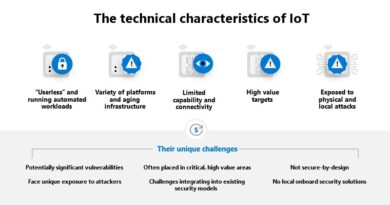The federal Zero Trust strategy and Microsoft’s deployment guidance for all
You’d be forgiven for missing the White House announcement on federal Zero Trust strategy on January 26, 2022.1 After all, on that day alone a Supreme Court Justice announced his intention to retire, the Federal Reserve announced its plan to raise interest rates, and the State Department was busy trying to reduce international tensions.
Even if it didn’t lead the evening news, the security announcement is a crucial milestone for all those that understand the importance of a Zero Trust model and are working hard to implement it. It’s no secret that government support for a technology can turbo-boost adoption—ask anyone who uses GPS, the internet, or electronic medical records.2 US Federal Government support for Zero Trust is similar: the Office of Management and Budget (OMB) has started an accelerated adoption curve for tens of millions of new endpoints.
There are 2.25 million full-time equivalent employees in the US federal executive branch, and 4.3m if you count postal workers and other staff in the judicial, legislative, and uniformed military branches.3 These also include many frontline workers, a critical security topic that I discuss in the blog post Reduce the load on frontline workers with the right management technology. The US Federal Government also sets the tone for technology policy in state and local government, which adds another 19.7 million workers, before we even begin to count federal government suppliers who will be asked to comply.4 Even at a ratio of one employee per endpoint (and the ratio could be higher with personal devices and IoT), not counting the endpoint strategy updates by overseas governments, we’re looking at tens of millions of endpoints that will be managed according to Zero Trust governance principles.
In full, I encourage you to read the memorandum press release, Office of Management and Budget Releases Federal Strategy to Move the U.S. Government Towards a Zero Trust Architecture.
Here are my three takeaways:
- Zero Trust is now relevant to every organization.
- Leadership alignment is the biggest obstacle to driving Zero Trust agendas.
- Zero Trust architecture requires holistic, integrated thinking.

Zero Trust is now relevant to every organization
Hybrid work, cloud migration, and increased threats make Zero Trust now relevant to every organization.
The concept of Zero Trust is not new. The term was first coined by then Forrester analyst John Kindervag in 2010.5 Yet, as the OMB paper says: “The growing threat of sophisticated cyber attacks has underscored that the Federal Government can no longer depend on conventional perimeter-based defenses to protect critical systems and data. The Log4j vulnerability is the latest evidence that adversaries will continue to find new opportunities to get their foot in the door.”
Yet, in our 2021 Zero Trust Adoption Report, only 35 percent of organizations claim to have fully implemented their Zero Trust strategy.
Zero Trust is now vitally relevant for every organization for two reasons. First, the shift to remote work and the accompanying cloud migration is here to stay. Gartner® estimates that 47 percent of knowledge workers will work remotely in 2022.6 This is not just a pandemic-era emergency that will reset to perimeter-based solutions once COVID-19 cases decrease. Today, security solutions must start from the fact that endpoints could be outside of a perimeter defense set-up and be tailored accordingly. Second, cyber threats continue to increase. The US Federal Government referenced the Log4j flaw but could equally have mentioned Kaseya, SolarWinds, or other recent disruptions. These disruptions are expensive—a 2021 IBM report put the average total cost of a breach of 1 to 10 million records at USD52 million, with a mega breach of 50 to 65 million records costing companies more than USD400 million.7
The US Federal Government is signaling that Zero Trust is essential for the current times. Zero Trust requires customers to think beyond firewalls and network perimeters and assume breach from within those boundaries.

Leadership alignment is the biggest obstacle to driving Zero Trust agendas
My second takeaway is that leadership alignment is critical to organizations making the proper progress in Zero Trust.
OMB requires that every agency nominate a Zero Trust strategy implementation lead within 30 days. Furthermore, the memorandum states: “Agency Chief Financial Officers, Chief Acquisition Officers, senior agency officials for privacy, and others in agency leadership should work in partnership with their IT and security leadership to deploy and sustain Zero Trust capabilities. It is critical that agency leadership and the entire ‘C-suite’ be aligned and committed to overhauling an agency’s security architecture and operations.” In short, this is not simply a technology problem that can be handed over to IT, never to be thought of again. Zero Trust requires, at a minimum, C-suite engagement and, given the risks involved in a security breach, also warrants board oversight.
Our Zero Trust Adoption Report that explores the barriers to Zero Trust implementation also highlighted leadership alignment. Fifty-three percent mentioned this as a barrier, covering C-suite, stakeholder, or broader organizational support. Other key barriers to adoption included limited resources, such as skills shortages in areas like change management, or the inability to sustain the length of time for implementation. For example, according to a 2020 annual Cybersecurity Workforce Study by (ISC)2, there remains a shortage of 3.1 million cybersecurity workers, including 359,000 in just the US.8 Related to this, budget constraints were mentioned by 4 in 10 survey respondents. Anticipating and proactively addressing leadership alignment, limited resources, and budget are key to the broader rollout of Zero Trust architectures, independent of any technology choices.
Zero Trust architecture requires holistic, integrated thinking
Zero Trust architecture thinking is more akin to conducting an orchestra than just flipping a switch. The US Federal Government’s plans encompass identity (including multifactor authentication and user authorization), devices (including endpoint detection and response), networks (including Domain Name System, HTTP, and email traffic encryption), apps and workloads, and data. This is not a project that can be done in silos or quickly. Indeed, the OMB asks federal agencies that “Within 60 days of the date of this memorandum, agencies must build upon those plans by incorporating the additional requirements identified in this document and submitting to OMB and Cybersecurity & Infrastructure Security Agency (CISA) an implementation plan for FY22 to FY24 for OMB concurrence, and a budget estimate for FY24.”
Microsoft’s and the US Federal Government’s Zero Trust frameworks are very similar. They overlap into five categories. Microsoft calls out infrastructure separately from networks, while the OMB memo combines the two. When thinking about Zero Trust, any organization needs to consider:
- Identities and authentication: Protecting identities against compromise and securing access to resources, including multifactor authentication.
- Endpoints and devices: Securing endpoints and allowing only compliant and trusted devices to access data.
- Applications: Ensuring applications are available, visible, and securing your important data.
- Data: Protecting sensitive data wherever it lives or travels.
- Networks: Removing implicit trust from the network and preventing lateral movement.
- Infrastructure: Detecting threats and responding to them in real-time.
Underscoring these pillars is centralized visibility, which enables a holistic view. Being able to see how all apps and endpoints are deployed and whether there are security issues is vital to maintaining as well as setting up a Zero Trust posture. An endpoint management solution provides a central repository for security policies and a place to enforce those policies should an endpoint no longer comply. Solutions should enable built-in encryption across all platforms, whether Windows, macOS, iOS, Android, or Linux. Equally, unified endpoint management will make the network journey towards Zero Trust easier, regardless of the type of network. Visibility matters in Zero Trust, and effective endpoint management is a major factor in delivering it.
Picking a starting point
Having a consistent framework for Zero Trust and constant visibility is a good starting point. Nonetheless, it doesn’t answer the question of where and how to start implementing Zero Trust for your organization. The answer will be specific to every organization—there is no one-size-fits-all approach for Zero Trust. Organizations may start at different points, but the Microsoft 365 Zero Trust deployment plan gives all organizations a practical guide to introduce Zero Trust.
The deployment plan has five steps and can help organizations implement a Zero Trust architecture:
- Configure Zero Trust identity and device access protection to provide a Zero Trust foundation.
- Manage endpoints by enrolling devices into management solutions.
- Add Zero Trust identity and device access protection to those devices.
- Evaluate, pilot, and deploy Microsoft 365 Defender to automatically collect, correlate, and analyze the signal, threat, and alert data.
- Protect and govern sensitive data to discover, classify, and protect sensitive information wherever it lives or travels.
Management of your apps and endpoints plays a vital and foundational role in any Zero Trust deployment. By enrolling devices into management, you can configure compliance policies to ensure devices meet minimum requirements and deploy those configuration profiles to harden devices against threats. With a solid foundation established, you can defend against threats by using device risk signals and ensure compliance using security baselines. In this way, you’re protecting and governing sensitive data, no matter what operating system platform your devices are using.
CISA Director Jen Easterly wrote in the memo’s press release: “As our adversaries continue to pursue innovative ways to breach our infrastructure, we must continue to fundamentally transform our approach to federal cybersecurity.” Zero Trust is a critical US Federal Government priority, which will accelerate mass adoption. If your organization is just starting to implement Zero Trust or further along, I hope the free resources below are helpful.
Learn more
Explore Microsoft’s resources and products to help you implement a Zero Trust strategy:
Read more about the US Federal Government’s Zero Trust strategy announcement:
Additional resources:
To learn more about Microsoft Security solutions, visit our website. Bookmark the Security blog to keep up with our expert coverage on security matters. Also, follow us at @MSFTSecurity for the latest news and updates on cybersecurity.
1US Government sets forth Zero Trust architecture strategy and requirements, Joy Chik, Microsoft. February 17, 2022.
250 inventions you might not know were funded by the US government, Abby Monteil, Stacker. December 9, 2020.
3Federal Workforce Statistics Sources: OPM and OMB, Congressional Research Service. June 24, 2021.
5Forrester pushes Zero Trust model for security, Dark Reading.
6Gartner, Forecast Analysis: Remote and Hybrid Workers, Worldwide, Ranjit Atwal, Rishi Padhi, Namrata Banerjee, Anna Griffen, 2 June 2021. GARTNER is a registered trademark and service mark of Gartner, Inc. and/or its affiliates in the U.S. and internationally and is used herein with permission. All rights reserved.
7Cost of a Data Breach Report 2021, IBM.
8Cybersecurity Workforce Study, (ISC)2. 2020.
READ MORE HERE



